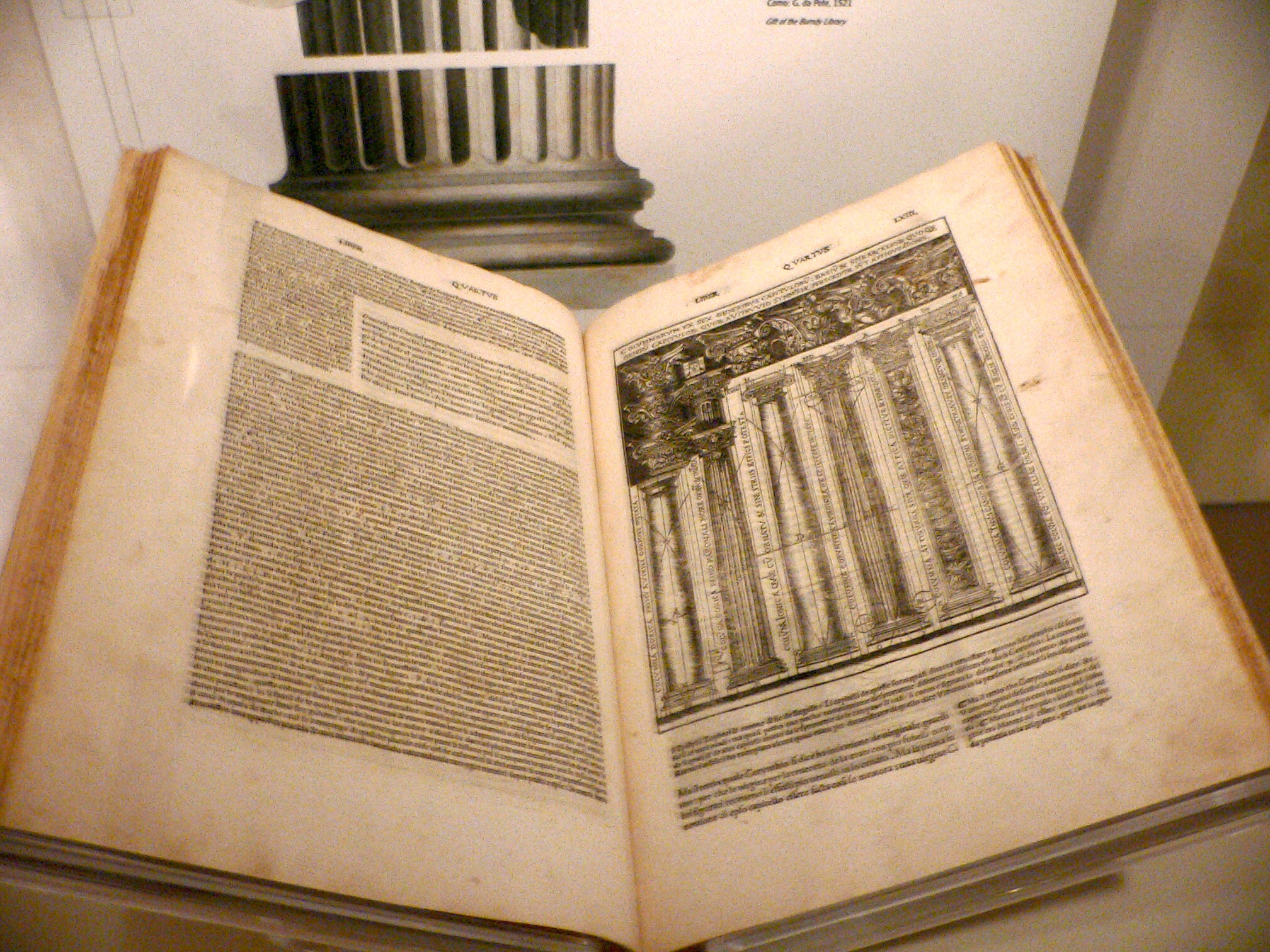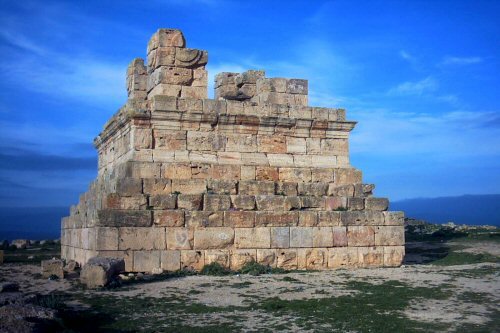|
Vitruvius Pollio
Vitruvius (; c. 80–70 BC – after c. 15 BC) was a Roman architect and engineer during the 1st century BC, known for his multi-volume work entitled ''De architectura''. He originated the idea that all buildings should have three attributes: , , and ("strength", "utility", and "beauty"). These principles were later widely adopted in Roman architecture. His discussion of perfect proportion in architecture and the human body led to the famous Renaissance drawing of the ''Vitruvian Man'' by Leonardo da Vinci. Little is known about Vitruvius' life, but by his own descriptionDe Arch. Book 1, preface. section 2. he served as an artilleryman, the third class of arms in the Roman military offices. He probably served as a senior officer of artillery in charge of ''doctores ballistarum'' (artillery experts) and ''libratores'' who actually operated the machines. As an army engineer he specialized in the construction of ''ballista'' and '' scorpio'' artillery war machines for sieges. ... [...More Info...] [...Related Items...] OR: [Wikipedia] [Google] [Baidu] |
De Architectura
(''On architecture'', published as ''Ten Books on Architecture'') is a treatise on architecture written by the Roman architect and military engineer Marcus Vitruvius Pollio and dedicated to his patron, the emperor Caesar Augustus, as a guide for building projects. As the only treatise on architecture to survive from antiquity, it has been regarded since the Renaissance as the first book on architectural theory, as well as a major source on the canon of classical architecture. It contains a variety of information on Greek and Roman buildings, as well as prescriptions for the planning and design of military camps, cities, and structures both large (aqueducts, buildings, baths, harbours) and small (machines, measuring devices, instruments). Since Vitruvius published before the development of cross vaulting, domes, concrete, and other innovations associated with Imperial Roman architecture, his ten books give no information on these hallmarks of Roman building design and technology ... [...More Info...] [...Related Items...] OR: [Wikipedia] [Google] [Baidu] |
Lucius Cornelius Balbus (major)
Lucius Cornelius Balbus ( 1st century BC) was born in Gades early in the first century BC. Lucius Cornelius Balbus was a wealthy Roman politician and businessman of Punic origin and a native of Gades in Hispania, who played a significant role in the emergence of the Principate at Rome. He was a prominent supporter of Julius Caesar and a close advisor to the emperor Augustus. He served in Hispania under Pompey and Metellus Pius against Sertorius. For his services against Sertorius, Roman citizenship was conferred upon him and his family by Pompey. He accompanied Pompey on his return to Rome in 71 BC, and was for a long time one of his most intimate friends. He also gained the friendship of Julius Caesar, who placed great confidence in him. Balbus' personal friendships with Pompey and Caesar were instrumental in the formation of the First Triumvirate. He was a chief financier in Rome. Balbus served under Caesar as chief engineer (''praefectus fabrum'') when Caesar was propraetor t ... [...More Info...] [...Related Items...] OR: [Wikipedia] [Google] [Baidu] |
Praefect
''Praefectus'', often with a further qualification, was the formal title of many, fairly low to high-ranking, military or civil officials in the Roman Empire, whose authority was not embodied in their person (as it was with elected Magistrates) but conferred by delegation from a higher authority. They did have some authority in their prefecture such as controlling prisons and in civil administration. Praetorian prefects The Praetorian prefect (''Praefectus praetorio'') began as the military commander of a general's guard company in the field, then grew in importance as the Praetorian Guard became a potential kingmaker during the Empire. From the Emperor Diocletian's tetrarchy (c. 300) they became the administrators of the four Praetorian prefectures, the government level above the (newly created) dioceses and (multiplied) provinces. Police and civil prefects *''Praefectus urbi'', or ''praefectus urbanus'': city prefect, in charge of the administration of Rome. *''Praefectus vigilu ... [...More Info...] [...Related Items...] OR: [Wikipedia] [Google] [Baidu] |
Roman Military Engineering
The military engineering of Ancient Rome's armed forces was of a scale and frequency far beyond that of any of its contemporaries. Indeed, military engineering was in many ways institutionally endemic in Roman military culture, as demonstrated by each Roman legionary having as part of his equipment a shovel, alongside his ''gladius'' (sword) and ''pila'' (spears). Fabri were workers, craftsmen or artisans in Roman society and descriptions of early Roman army structure (Phalanx, the Legion came around the conquest of Greece) attributed to king Servius Tullius describe there being two centuriae of fabri under an officer, the praefectus fabrum. Roman military engineering took both routine and extraordinary forms, the former a proactive part of standard military procedure, and the latter of an extraordinary or reactionary nature. Proactive and routine military engineering The Roman legionary fortified camp Each Roman legion had a military legionary fort as its permanent base. Howev ... [...More Info...] [...Related Items...] OR: [Wikipedia] [Google] [Baidu] |
Mamurra
Mamurra () was a Roman military officer who served under Julius Caesar. Biography Early life Possibly named Marcus Vitruvius Mamurra (if we follow Thielscher's 1969 suggestion based on an inscription in Thibilis), he was an equestrian who originally came from the Italian city of Formiae.Pliny the Elder, '' Natural History'36.7/ref> His family must have been prominent there, as Horace calls it "the city of the Mamurrae". His large villa-estate of Gianola is traditionally that which can still be seen near Formia. Military career He served as ''praefectus fabrum'' (prefect of engineers) under Caesar in Gaul; a poem by Catullus also refers to his service in Britain as well as in Pontus and Hispania,Catullus, ''Carmina'29/ref> suggesting he also served during the civil war. Among the engineering feats achieved by Caesar's army during this time, which Mamurra may have been a part of, include the rapid construction of a bridge over the Rhine in 55 BC, the designing and building of a n ... [...More Info...] [...Related Items...] OR: [Wikipedia] [Google] [Baidu] |
Numidia
Numidia ( Berber: ''Inumiden''; 202–40 BC) was the ancient kingdom of the Numidians located in northwest Africa, initially comprising the territory that now makes up modern-day Algeria, but later expanding across what is today known as Tunisia, Libya, and some parts of Morocco. The polity was originally divided between the Massylii in the east and the Masaesyli in the west. During the Second Punic War (218–201 BC), Masinissa, king of the Massylii, defeated Syphax of the Masaesyli to unify Numidia into one kingdom. The kingdom began as a sovereign state and later alternated between being a Roman province and a Roman client state. Numidia, at its largest extent, was bordered by Mauretania to the west, at the Moulouya River, Africa Proconsularis to the east, the Mediterranean Sea to the north, and the Sahara to the south. It was one of the first major states in the history of Algeria and the Berbers. History Independence The Greek historians referred to these peoples as ... [...More Info...] [...Related Items...] OR: [Wikipedia] [Google] [Baidu] |
Lucius Vitruvius Cordo
Lucius Vitruvius Cerdo was an ancient Roman architect active in Verona. His only known work is the Arco dei Gavi, a 1st-century arch in Verona, Italy. The arch is inscribed "Lucius Vitruvius Cerdo, a freedman of Lucius", which has led to Verona being suggested as the birthplace of the earlier and better-known architect Marcus Vitruvius Pollio Vitruvius (; c. 80–70 BC – after c. 15 BC) was a Roman architect and engineer during the 1st century BC, known for his multi-volume work entitled ''De architectura''. He originated the idea that all buildings should have three attribute .... References 1st-century Romans Ancient Roman architects History of Verona Year of death unknown Year of birth unknown Architects from Verona {{AncientRome-bio-stub ... [...More Info...] [...Related Items...] OR: [Wikipedia] [Google] [Baidu] |
Marcus Cetius Faventinus
Marcus Cetius Faventinus was a Roman author on architecture active in the late 3rd or early 4th century AD. He wrote a handbook based mainly on earlier authors, especially Vitruvius. It was intended mainly for private builders. Its original title was ''Artis architectonicae privatis usibus adbreviatus liber'' ('abridged book of the art of architecture for private uses'), but is now more commonly known as ''De diversis fabricis architectonicae''. It was used by the agricultural writer Palladius and by the encyclopaedist Isidore of Seville. It was also known by Sidonius Apollinaris Gaius Sollius Modestus Apollinaris Sidonius, better known as Sidonius Apollinaris (5 November of an unknown year, 430 – 481/490 AD), was a poet, diplomat, and bishop. Sidonius is "the single most important surviving author from 5th-century Gaul .... There is a modern English translation with a facing Latin edition. Notes Bibliography * * * {{refend 3rd-century Romans 4th-century Romans 3rd-cent ... [...More Info...] [...Related Items...] OR: [Wikipedia] [Google] [Baidu] |
Woodcut
Woodcut is a relief printing technique in printmaking. An artist carves an image into the surface of a block of wood—typically with gouges—leaving the printing parts level with the surface while removing the non-printing parts. Areas that the artist cuts away carry no ink, while characters or images at surface level carry the ink to produce the print. The block is cut along the wood grain (unlike wood engraving, where the block is cut in the end-grain). The surface is covered with ink by rolling over the surface with an ink-covered roller (brayer), leaving ink upon the flat surface but not in the non-printing areas. Multiple colors can be printed by keying the paper to a frame around the woodblocks (using a different block for each color). The art of carving the woodcut can be called "xylography", but this is rarely used in English for images alone, although that and "xylographic" are used in connection with block books, which are small books containing text and images in t ... [...More Info...] [...Related Items...] OR: [Wikipedia] [Google] [Baidu] |
Fra Giovanni Giocondo
Giovanni Giocondo, Order of Friars Minor, (c. 1433 – 1515) was an Italian friar, architect, antiquary, archaeologist, and classical scholar. Biography Giovanni Giocondo was born in Verona around 1433. He joined the Dominican Order at the age of eighteen. Afterwards, however, he left the Dominicans and entered the Franciscan Order. Giocondo began his career as a teacher of Latin and Greek in Verona, where Julius Caesar Scaliger was one of his pupils. As a young priest, Friar Giovanni was a learned archaeologist and a superb draughtsman. He visited Rome, sketched its ancient buildings, wrote the story of its great monuments, and recorded, deciphered and explained many defaced inscriptions. He stimulated the revival of classical learning by making transcriptions of ancient manuscripts, one of which, completed in 1492, he presented to Lorenzo de' Medici. Giocondo soon returned to his native town where he built bridges and planned fortifications for Treviso, acting as archit ... [...More Info...] [...Related Items...] OR: [Wikipedia] [Google] [Baidu] |
Venice
Venice ( ; it, Venezia ; vec, Venesia or ) is a city in northeastern Italy and the capital of the Veneto Regions of Italy, region. It is built on a group of 118 small islands that are separated by canals and linked by over 400 bridges. The islands are in the shallow Venetian Lagoon, an enclosed bay lying between the mouths of the Po River, Po and the Piave River, Piave rivers (more exactly between the Brenta (river), Brenta and the Sile (river), Sile). In 2020, around 258,685 people resided in greater Venice or the ''Comune di Venezia'', of whom around 55,000 live in the historical island city of Venice (''centro storico'') and the rest on the mainland (''terraferma''). Together with the cities of Padua, Italy, Padua and Treviso, Italy, Treviso, Venice is included in the Padua-Treviso-Venice Metropolitan Area (PATREVE), which is considered a statistical metropolitan area, with a total population of 2.6 million. The name is derived from the ancient Adri ... [...More Info...] [...Related Items...] OR: [Wikipedia] [Google] [Baidu] |





.jpg)